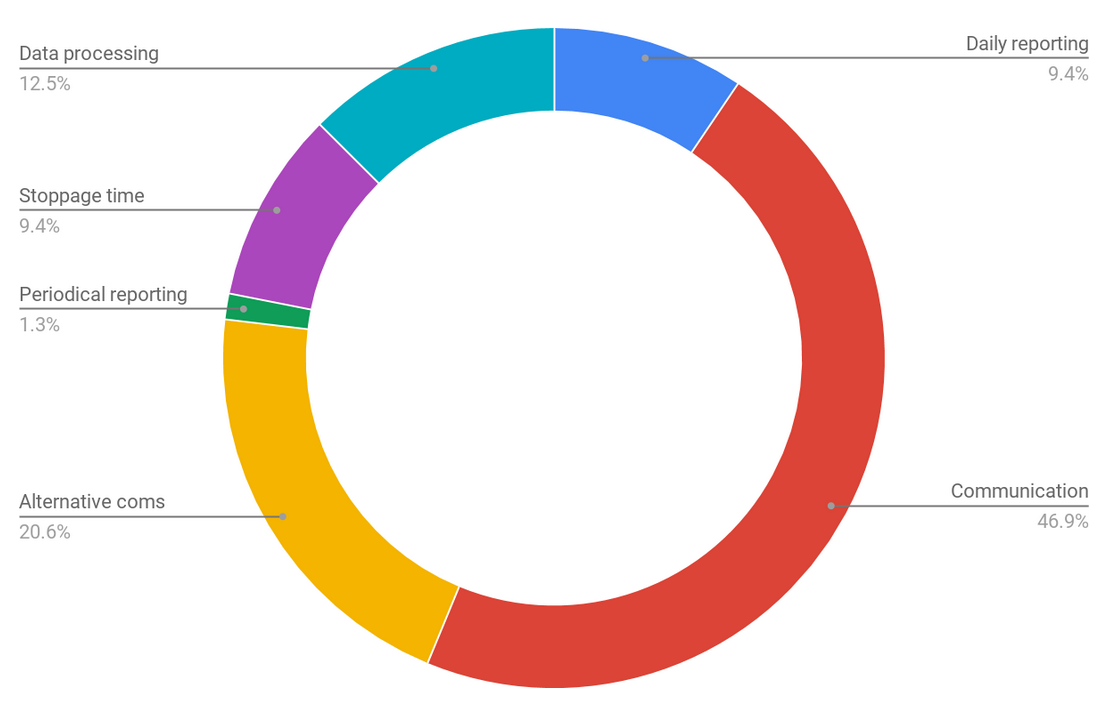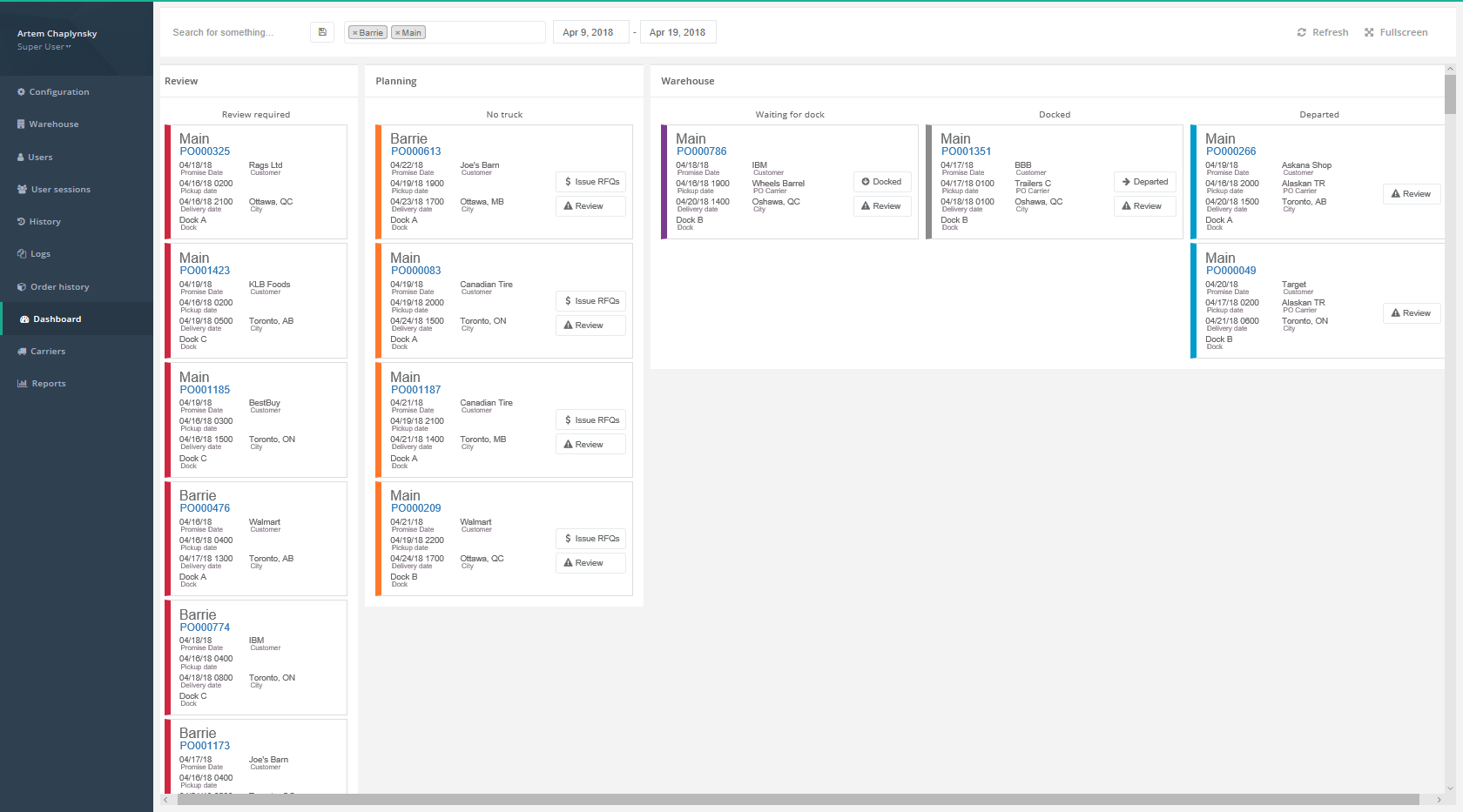General details
Duration: 4 months
Project outcome: Delivered on time and within budget
Result: Saved 20 hours of work per day by automating logistics at the head office and production facilities
Whitepaper
This project and solution are the outcome of research done at the client's office, which involved detailed investigation of logistics operations and employee interviews. Conversations with employees and their resulting feedback is sensitive in nature. Care was taken to ensure that employees feel comfortable sharing their opinions and anonymity was granted on matters and information that does not need an author to be deemed valid.
Project goals
-
Provide accurate, real-time data
-
Streamline the order fulfillment lifecycle
-
Automate time-consuming reporting
Approach
Prior to the start of this study, several initial assumptions were made:
-
Employees are overburdened with highly repetitive tasks.
-
Departments lack communication with each other.
-
Logistical problems arise due to the low availability of required information.
The above assumptions were tested in 3 independent stages:
-
Employees were approached with several specific requests - to explain the most routine daily process, to describe the most time-consuming part of their days, and to name something that makes them frustrated on a regular basis.
-
The daily tasks that were identified as time-consuming by the employees were timed to verify the validity of the claims made.
-
A workflow of the current fulfillment lifecycle was created, in order to clearly identify the roles that the departments play and further test the initial assumptions.
Findings
During the conduct of this study, the following aggravating issues were identified:
-
Low morale due to simple, repetitive tasks.
-
Current software constantly freezes, which forces people to do the same work twice; occurrence - at least twice per day.
-
Data is difficult to access immediately due to the long load times of the current ERP system.
-
Management does not have an easy way of getting analytical information and relies on employees to supply it, even further burdening the departments.
-
Roles are dispersed among multiple departments (i.e. buyers, logistics associates, and CSRs all do some form of logistics, which purportedly reduces their individual departmental efficiency). This is caused by the fact that each department is extremely burdened with their daily routine.
In addition to the above, the initial assumptions were confirmed. As can be seen in Figure 1, employees spend a large amount of their time on tasks that can be automated, such as reporting, manual data processing and communication. Even though, communication will still be the most time-consuming daily task it is possible to simplify it and effectively cut it in half by implementing an automated notification system and a messaging centre that will give an immediate overview of the issue in question (e.g. details of a fulfillment order, carrier ratings, shipping line prices).
Figure 1 - Average daily time allocation

Furthermore, departments burden each other with requests for information that should be easily accessible for the department that needs access to it. Here is an example: the logistics department needs the reason a carrier rejected the tender that the CSRs sent to them, because they utilize this information for reporting purposes. However, quite often, to get this information they need to contact a CSR or search in an email folder. Not only should the reports be generated automatically, as the information needed for them is already stored in the company’s databases, but the departments that start certain tasks need to complete them and report on them themselves. The transfer of responsibilities between departments adds up to a large portion of the daily ‘Communication’ task visualized in Figure 1. Nonetheless, due to the time constraints of this study, it must be noted that empirical data to support such a claim has not been gathered.
Communication and planning is further hindered by the unreliable, slow systems in place. Departments, including plants and warehouses, are simply not on the same page, because the ERP system takes an average of 6 minutes to update. Consequently, the information may become outdated even before it loads. At the moment, employees try to refresh the data once every hour, as doing this more often would significantly increase stoppage time. Because changes are not synced automatically, the data displayed between updates is inaccurate. To solve the discrepancies that arise, employees resort to calling the owners of the information they need, in order to get an update (e.g. calling a warehouse to get an update on a truck’s status). Every call takes time.
Solution overview
The new system was built using Microsoft’s technology stack and will be hosted on Microsoft Azure. We utilized two databases - SQL Server for transactional data and Mongo DB for historical data. The latter allowed us to keep track of all changes that happen in the portal and log the date and time stamp of the change along with the name of the user who did the change. This will greatly increase the accountability of every employee.
The frontend was built following the SPA (Single-Page Application) model.
We integrated with the existing Oracle database to pull data at pre-determined time intervals and write information back via declared touch points. Should any field be modified in the Oracle database it will be synchronized automatically with the new system. Write access will be minimized to the bare necessities that will improve the company’s operations.
There were concerns that the new system will overburden the existing database server. However, any new load on the existing database was minimal and did not negatively impact the other systems in place. Ultimately, a significant load reduction was confirmed with the launch of the new system, because each employee no longer made pull requests individually. Our system keeps up-to-date data for everyone and limits access to it based on the departments the users belong to and their individual roles.
User Interface
The fulfillment lifecycle follows a pre-determined workflow. Therefore, it was beneficial to employ a Kanban board to display the orders for the employees to work on. Each order flows from one column to the next, based on its state. Paired with the departmental and individual user permissions this means that each department sees the piece of the Kanban board that pertains to their role in the lifecycle of each fulfillment order. This reduced clutter and allowed our client's employees to focus on the information they need, which is available either directly on the board or a single click away.
